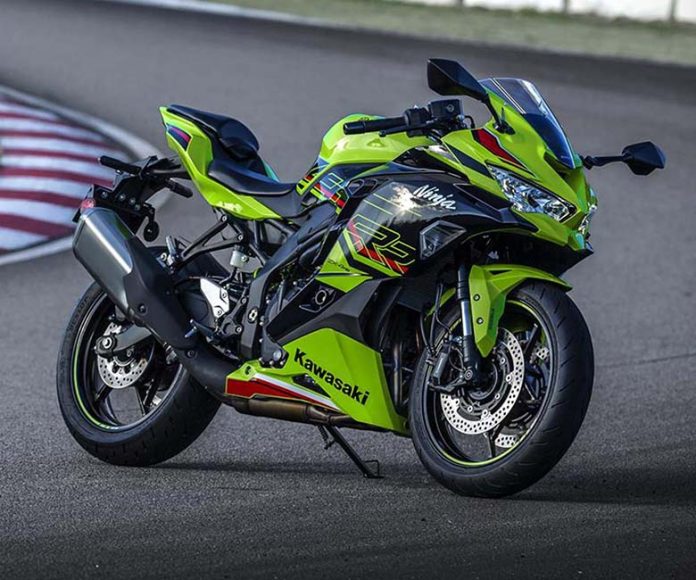Kawasaki offers a ground-breaking supersport vehicle in a class of 400cc sports models. The 2023 Kawasaki Ninja ZX-4R Sports Motorcycle has a compact chassis roughly the same size as the Ninja ZX-250R and is powered by a 399cc inline-four engine that delivers class-leading performance.
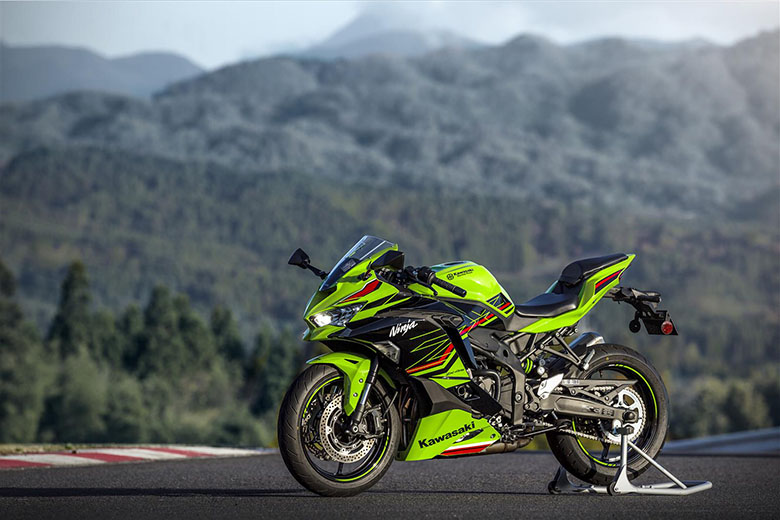
The 2023 Kawasaki Ninja ZX-4R Sports Motorcycle’s mighty power, addictive high-rpm scream, and crisp, quick handling will awaken the dormant supersport in you, whether you’re on the track or the road.
2023 Kawasaki Ninja ZX-4R Sports Motorcycle – Features and Specs
Assist & Slipper Clutch
The assist-and-slipper clutch employs two types of cams—an assist cam and a sleeper cam—to drive the clutch hub and operating plate together or separately, depending on the feedback from racing operations. When the assist cam is in normal operating condition, it acts as a self-servo mechanism, compressing the clutch plates by pulling the clutch hub and operating plate together.
Also Read: 2023 Kawasaki Z H2 Sports Motorcycle Review
It reduces the overall load on the clutch spring, which lightens the feel of the clutch lever during clutch engagement. Sudden or inadvertent downshifts can cause excessive engine braking. In these cases, the sleeper cam separates and pushes the clutch hub and operating plate.
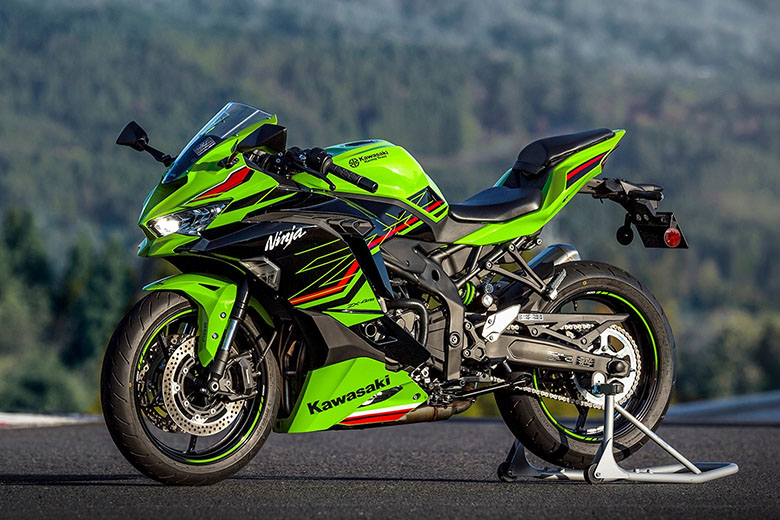
Economical Riding Indicator
The new 2023 Kawasaki Ninja ZX-4R Sports Motorcycle can achieve high fuel efficiency levels through high-precision electronic controls for engine management. However, the rider’s gear choice, throttle, and other factors significantly impact fuel consumption. The Economy Ride indicator shows when driving conditions are optimal for fuel consumption.
Also Read: 2023 Kawasaki Z H2 SE Sports Motorcycle Review
Regardless of bike speed, engine speed, throttle position, or other riding parameters, the system continuously tracks the fuel used. When fuel efficiency is good, or fuel consumption is low for a certain speed, the “ECO” symbol appears on the instrument panel’s LCD screen. Fuel consumption can be reduced by riding so that the “ECO” mark is maintained.
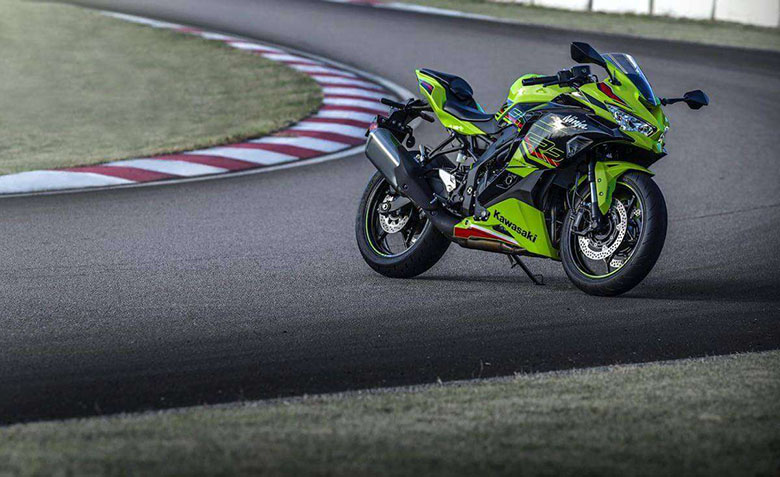
Although a model’s effective speed and engine speed may vary, riders can increase their fuel efficiency by observing the conditions that lead to the appearance of the “ECO” symbol. This is an easy way to increase their vehicle’s range. Additionally, reducing fuel consumption reduces the negative impact on the environment.
Electronic Throttle Valves
Thanks to 2023 Kawasaki Ninja ZX-4R Sports Motorcycle’s fully electronic throttle activation system, which uses throttle valves to regulate air and fuel delivery, the engine’s fuel and air delivery volumes can be adjusted via the ECU. Proper fuel injection and throttle valve positioning result in excellent engine output and smooth, natural engine response. The system also plays an important role in reducing emissions.
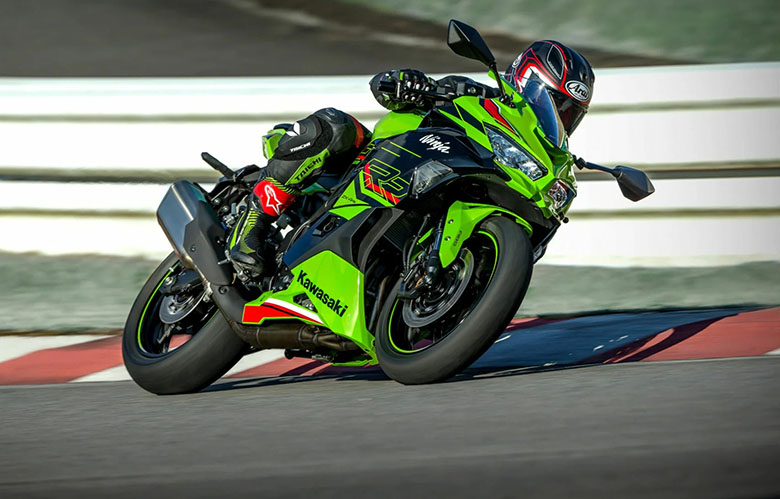
Additionally, electronic throttle valves facilitate the deployment of electronic systems like KLCM, Kawasaki Engine Brake Control, and electronic cruise control, as well as accurate management of electronic engine management systems such as S-KTRC and KTRC.
KTRC (Kawasaki Traction Control)
The engine’s fuel and air delivery volumes can be adjusted via the ECU thanks to 2023 Kawasaki Ninja ZX-4R Sports Motorcycle’s fully electronic throttle activation system, which uses throttle valves to regulate air and fuel delivery. Proper fuel injection and throttle valve positioning result in excellent engine output and smooth, natural engine response. The system also plays an important role in reducing emissions.
Additionally, electronic throttle valves facilitate the deployment of electronic systems like KLCM, Kawasaki Engine Brake Control, and electronic cruise control, as well as more precise management of electronic engine management systems such as S-KTRC and KTRC.
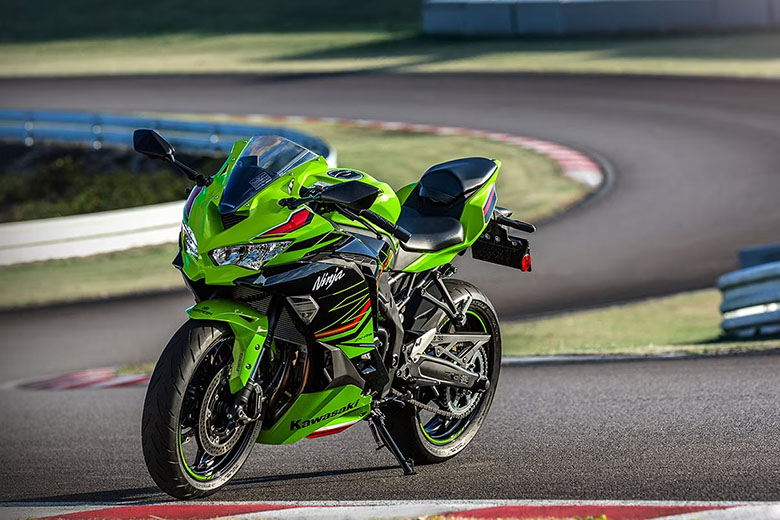
Additionally, 2023 Kawasaki Ninja ZX-4R Sports Motorcycle’s advanced software can account for corner camber, gradient, and other factors because it bases its dynamic analysis on the chassis’ orientation concerning the track surface rather than the horizontal plane. When excessive wheelspin is detected in the more intrusive modes (and for some models, in any mode), engine output is reduced to restore grip, allowing riders to navigate both short, tight areas (such as manhole covers or train tracks) with confidence and long stretches of rough terrain (such as wet pavement, cobblestones, and gravel).
Power Modes
Multiple power mode models allow riders to easily change the engine’s power delivery to suit their preferences or riding conditions. In addition to the full power option, one (low) or two (medium, low) other modes are available that limit maximum power and have a softer throttle response.
Smartphone Connectivity
Innovative technology allows riders to establish a wireless connection with their motorcycle. With the smartphone application “Rideology The APP,” one can access a number of device features that enhance the motorcycle riding experience. The smartphone can display vehicle information, such as the odometer, fuel gauge, maintenance schedule, etc. The smartphone can also be used to check riding logs, which vary by model and can include GPS route, gear position, rpm, and other information.
When connected, telephone (call, mail) notifications are displayed on the instrument panel. Riders can also adjust selected units, clock, date, and other settings on their motorcycle’s instrument display using a smartphone. Additionally, you can use your smartphone to check and modify vehicle settings on some models.
ABS (Anti-Lock Brake System)
Front and rear wheel sensors continuously measure wheel speed through the Kawasaki ABS system. If data from any of the sensors indicates that the wheel is locked, the new ABS ECU instructs the pump in the ABS unit to regulate the brake fluid pressure to maintain traction until normal operation is restored. Release and reapply pressure as needed to restore traction. ABS gives riders confidence, which enhances their riding enjoyment.
Horizontal Back-link Rear Suspension
With the horizontal back-link rear suspension, the shock unit is almost horizontal, unlike the vertically mounted Uni-Trak rear suspension used by 2023 Kawasaki Ninja ZX-4R Sports Motorcycle. The original Kawasaki suspension design significantly aids mass centralization, placing the shock unit close to the bike’s center of gravity.
Additionally, a larger exhaust pre-chamber (an exhaust expansion chamber located slightly upstream of the silencer) can be installed since there is no linkage or shock unit behind the swingarm. More excellent mass centralization can be achieved by reducing silencer volume and concentrating more exhaust components closer to the bike’s center of gravity with a larger pre-chamber. This results in a significant increase in handling.
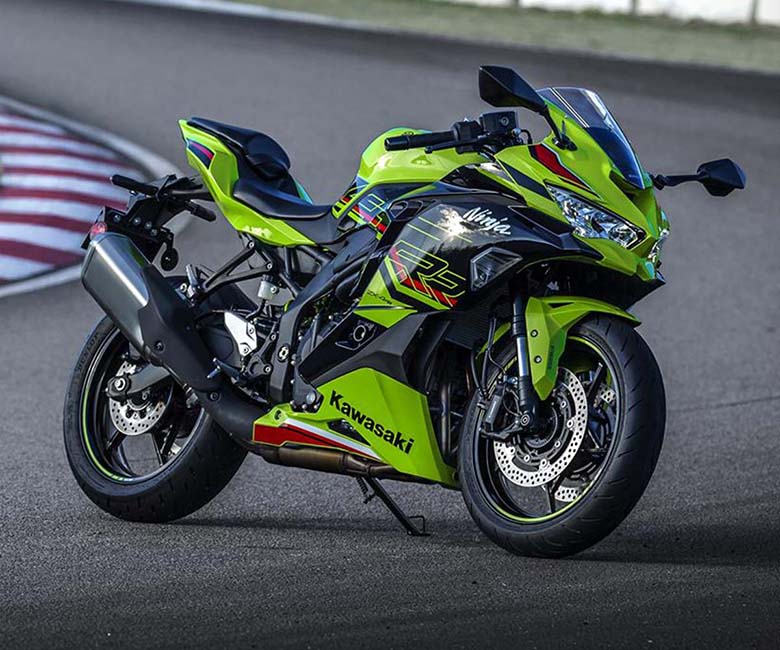
The shock unit’s location far from the exhaust hood is a bonus. Suspension performance is more consistent because heat from the exhaust system is less likely to affect suspension oil and gas pressure adversely.
2023 Kawasaki Ninja ZX-4R Sports Motorcycle – Technical Specifications
Power
| Engine | 399cc, liquid-cooled, 4-stroke, DOHC 16-valve in-line four |
| Bore x Stroke | 57.0 x 39.1 mm |
| Compression Ratio | 12.3:1 |
| Fuel System | Fuel injection: ø34 mm x 4 |
| Ignition | Digital |
| Starting | Electric |
| Lubrication | Forced lubrication, wet sump |
| Transmission | 6-speed, return |
| Clutch | Wet multi-disc, manual |
| Final Drive | Chain |
Performance
| Frame | Trellis, high-tensile steel |
| Front Suspension / Wheel Travel | 37mm inverted fork (SFF-BP) including top-out springs / 120 mm (4.7 in) |
| Rear Suspension / Wheel Travel | Horizontal Back-link, gas-charged shock including spring preload adjustability / 112 mm (4.4 in) |
| Rake / Trail | 23.5-degree / 97mm |
| Steering Angle (L/R) | 35-degree / 35-degree |
| Front Tire | 120/70ZR17M/C (58W) |
| Rear Tire | 160/60ZR17M/C (69W) |
| Front Brakes | Dual semi-floating 290mm discs featuring radial-mount, monobloc, opposed 4-piston calipers |
| Rear Brake | ø220 mm disc with single-piston caliper |
Details
| Dimensions (L x W x H) | 1,990 mm x 765 mm x 1,110 mm (78.3 in x 30.1 in x 43.7 in) |
| Wheelbase | 1,380 mm (54.3 in) |
| Road Clearance | 135 mm (5.3 in) |
| Seat Height | 800 mm (31.5 in) |
| Curb Mass | 188 kg (414 lb) |
| Fuel Capacity | 15 litres |
| Instrumentation | Full-colour TFT screen with digital speedometer, digital bar-style tachometer, gear position indicator, shift indicator (tachometer flashes), fuel gauge, odometer, dual trip meters, current and average fuel consumption, remaining range, average speed, riding time, coolant temperature, clock, battery voltage, lap timer (Circuit Mode only), Kawasaki service reminder, oil change reminder, integrated Riding Mode, KTRC, and Power Mode indicators, smartphone call and mail notices, Bluetooth indicator, and Economical Riding Indicator |
| Warranty | 12 months |
| Kawasaki Protection Plus | 12 / 24 / 36 / 48 months |

